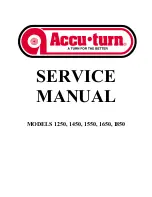
- 55 -
9.01
Status Messages
Every time the WP20 is powered up it immediately performs two functions.
The first function is a scan to determine if an optional plug-in field-bus communications
interface card is installed. The following message will be displayed:
“SCANNING FOR BUSCARD”
The second function is a test of the RAM memory “chip”, and then the flash memory “chip” that
stores the backup “flash” Parameters. The word “chip” is a commonly used substitute word for
I
ntegrated
C
ircuit (IC). RAM stands for
R
andom
A
ccess
M
emory, which is a type of memory
that will loose its information when unpowered. Flash memory is a type of memory that will
retain its information when unpowered. These tests are performed to assure that no information
has been “scrambled”, lost, or corrupted. When the tests are complete, one of the following
messages will appear in the MODE window:
“SELF TEST – PASS”
The
memory is OK. No changes have occurred.
“RAM BAD, FLASH RESTORE”
The RAM memory is corrupt. The WP20 has restored the
Parameter Table from flash memory.
“RAM/FLASH BAD, DEFAULTS”
Both the RAM and flash memory are corrupt. The WP20
has restored the Parameter Table from the default
memory. (User determined Parameters will need to be re-
entered. Refer to Sections 6 and 11).
The MODE window can display many different messages that either indicate a potential problem
or convey status information. Some of them have already been discussed as needed throughout
this manual. The following discussion expands on some of those messages and also includes
messages that have not yet been discussed. The following discussion assumes that how to
navigate through the menus and KEYPAD use is understood. Refer to Section 5 if not.
“AUTO ZERO ERROR”
or
“AUTO SPAN ERROR”
The AUTO ZERO and AUTO SPAN error messages indicate an abnormal condition during
calibration. Press the RESET button to clear the message and perform another AUTO ZERO.
After a successful AUTO ZERO has been done, do another AUTO SPAN.
Possible causes of the message:
•
Rocks (or material) were jammed under the weigh idler.
•
The cal weight was lowered for an AUTO ZERO, when it should have been raised.
•
The cal weight was raised for an AUTO SPAN, when it should have been lowered.
•
The conveyor had material running on it during calibration.
•
The load cell(s) or LVDT(s) are damaged.
•
The belt skirting was touching the weigh idler or the belt near the scale.
•
The Parameters for Weigh Span, Cal Weight, etc. are incorrect.
•
The Load Count Parameter does not increase when the calibration weight is lowered.
CHAPTER 9 – TROUBLESHOOTING
Содержание Tecweigh 20
Страница 2: ... 1 ...
Страница 10: ... 9 2 09 I O Quick Reference Guide ...
Страница 20: ... 19 ...
Страница 24: ... 23 4 03 WY15 and WY25 Scale Wiring load cells ...
Страница 25: ... 24 4 04 HY15 and HY25 Field Wiring ...
Страница 26: ... 25 4 05 WY10 WY10HD and WY20 Scale Wiring LVDTs ...
Страница 27: ... 26 4 06 Chart Recorder Data Logger using the 4 20 ma output ...
Страница 28: ... 27 4 07 Chart Recorder Data Logger using the HFR output ...
Страница 29: ... 28 4 08 Remote Rate Total Display 4 09 Remote Tons Counter ...
Страница 30: ... 29 4 10 Radio Transceivers Local Scale Remote Processor ...
Страница 31: ... 30 4 11 Radio Transceivers Local Processor Remote PLC PC or Remote Display ...
Страница 32: ... 31 4 12 Radio Transceivers Local DC Generator Remote Processor ...
Страница 33: ... 32 4 13 Radio Transceivers Local DC Generator and Processor ...
Страница 34: ... 33 4 14 Multiple Processors to Tecweigh Multi Scale Display MSD ...
Страница 35: ... 34 4 15 Interposing Relay External 120 vac Power 4 16 Interposing Relay Internal 30 vdc Power ...
Страница 61: ... 60 SC300 PCB WY15 and WY25 SC400 PCB WY10 and WY20 ...
Страница 71: ... 70 10 01 WY10 Dimensions CHAPTER 10 DIMENSIONS ...
Страница 72: ... 71 10 02 WY10 HD Heavy Duty Dimensions ...
Страница 73: ... 72 10 03 WY15 Dimensions ...
Страница 74: ... 73 10 04 WY20 Dimensions ...
Страница 75: ... 74 10 05 WY25 Dimensions ...
Страница 76: ... 75 10 06 HY15 and 25 Dimensions ...
















































